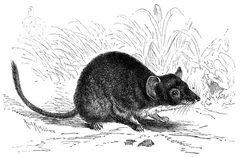Antechinus
| Antechinus | |
|---|---|
 | |
| Antechinus flavipes, from Brehms Tierleben | |
| Scientific classification | |
| Kingdom: | Animalia |
| Phylum: | Chordata |
| Class: | Mammalia |
| Order: | Dasyuromorphia |
| Family: | Dasyuridae |
| Subfamily: | Dasyurinae |
| Tribe: | Phascogalini |
| Genus: | Antechinus Macleay, 1841 |
| Type species | |
| Antechinus stuartii Macleay, 1841 | |
| Species | |
| |
Antechinus /æntɪˈkaɪnəs/ ('ant+echinus' - resembling a mouse with the bristly fur of a hedgehog) is a genus of dasyurid marsupial that is indigenous to Australia (including Tasmania and some outlying islands) and New Guinea. The majority of Antechinus species occur in Australia and only two species (currently with a putative third) have been described in New Guinea. Members of this species have been called broad-footed marsupial mice, pouched mice, or antechinus shrews. However, these common names are to be considered either regional or archaic and the modern common name for animals of this genus is 'antechinus'.
Antechinuses are small, carnivorous, shrew-like animals that primarily prey on invertebrates such as spiders, beetles (including larvae), and weevils. Some are strictly terrestrial and hunt only at ground level, while others are highly scansorial (climbing) in nature. Most species nest communally in tree-hollows.
Their habitat is primarily: temperate rainforest, dry and wet eucalypt forest, healthy woodlands (A. agilis / A. stuartii); temperate rainforest (A. swainsonii); swamps, wet heaths (A. minimus); disturbed or open woodlands, dry/wet, tropical/subtropical/temperate eucalypt forest/rainforest, healthy woodlands (A. flavipes [highly widespread]); tropical rainforest (A. godmani, A. leo); tropical/subtropical vine-forests (A. subtropicus, A. adustus); monsoonal open forest (A. bellus).
Antechinuses have short hair and vary from grey-cinnamon-brown-black in colour depending on the species. They have prominent whiskers, large ears and a pronounced, pointed snout, giving them an overall shrew-like appearance. Species vary from 80–120 mm, nose-to-tail (80 mm = female A. agilis, 120 mm = male A. swainsonii) and weight 16–170 g (16 g = female A. agilis, 170 g = male A. swainsonii) when fully grown.
Sexual dimorphism occurs in most species for both weight and skeletal measurements, with males being typically larger and heavier. A. agilis is the smallest known species, and A. swainsonii the largest. Species in Papua New Guinea are not well documented and unknown Papuan species and subspecies likely await discovery.
Reproduction
All Antechinus species except for A. swainsonii are semelparous at least as males – and usually as females too – meaning that an individual will usually only live long enough to breed once in its lifetime. Breeding occurs in winter (usually August–September) at a time when there is little food available in the environment.
To accomplish this the males strip their body of vital proteins and also suppress the immune system so as to free up additional metabolic energy. In this way an individual male trades away long-term survival in return for short-term breeding success, and following the breeding season there is a complete die-off of physiologically exhausted males.[1] Breeding is intensely competitive. Males produce large amounts of testosterone and mate-guarding occurs in the form of protracted copulation (up to twelve hours in some species).
The females can store sperm for up to three days in specialized sperm-storage crypts in the ovary and do not ovulate until the end of the breeding season. Many litters have multiple paternity (i.e. several fathers contribute to a single litter). Females can live for 2–3 years. However, this is unusual, and most females die following the weaning of their first litter. Litters size depends on the number of teats in the pouch.
There are as few as four teats, usually eight, and in some populations up to ten can occur. It is currently unknown why teat number varies. However, it is likely that in food-poor environments selection has tended towards fewer teats so that there is a greater parental investment per offspring.
Antechinus babies can weigh as little as 4 grams and are some of the smallest Australian marsupial babies.
Species

- Antechinus adustus (Thomas, 1923) (Tropical Antechinus)
- Antechinus agilis Dickman, et al. 1998 (Agile Antechinus)
- Antechinus argentus Baker, Mutton & Hines, 2013 (Silver-headed Antechinus)[2]
- Antechinus arktos Baker, Mutton, Hines & Van Dyck, 2014 (Black-tailed Antechinus)
- Antechinus bellus (Thomas, 1904) (Fawn Antechinus)
- Antechinus flavipes (Waterhouse, 1837) (Yellow-footed Antechinus)
- Antechinus godmani (Thomas, 1923) (Atherton Antechinus)
- Antechinus leo van Dyck, 1980 (Cinnamon Antechinus)
- Antechinus minimus (É. Geoffroy Saint-Hilaire, 1803) (Swamp Antechinus)
- Antechinus mysticus Baker, Mutton & van Dyck, 2012 (Buff-footed Antechinus)[3]
- Antechinus stuartii (Macleay, 1841) (Brown Antechinus)
- Antechinus subtropicus van Dyck and Crowther, 2000 (Subtropical Antechinus)
- Antechinus swainsonii (Waterhouse, 1840) (Dusky Antechinus)
References
- ↑ "Daddy Dearest". .canada.com. 1910-06-19. Retrieved 2014-06-26.
- ↑ Andrew M Baker, Thomas Y Mutton & Harry B Hines (2013). "A new dasyurid marsupial from Kroombit Tops, south-east Queensland, Australia: the Silver-headed Antechinus, Antechinus argentus sp. nov. (Marsupialia: Dasyuridae)". Zootaxa 3746 (2): 201–239. doi:10.11646/zootaxa.3746.2.1.
- ↑ Baker, A.M.; Mutton, T.Y.; Dyck, S. van 2012: A new dasyurid marsupial from eastern Queensland, Australia: the buff-footed Antechinus, Antechinus mysticus sp. nov. (Marsupialia: Dasyuridae). Zootaxa, (3515): 1-37. Preview
- Black-tailed Antechinus discovery
- Groves, C. P. (2005). Wilson, D. E.; Reeder, D. M, eds. Mammal Species of the World (3rd ed.). Baltimore: Johns Hopkins University Press. pp. 28–30. OCLC 62265494. ISBN 0-801-88221-4.
- "Antechinus". Integrated Taxonomic Information System. Retrieved 2 February 2006.
| Wikispecies has information related to: Antechinus |